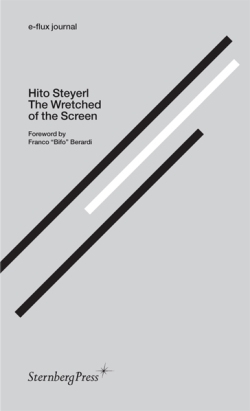I picked up a copy of Hito Steyerl’s book The Wretched of the Screen at the ICA bookshop in London when she had an exhibition there a few months ago. She’s a video artist based in Berlin and her work is a brilliant commentary on the mediation of different kinds of visuality by digital technologies. The most interesting piece in the exhibition for me was called How Not To Be Seen: A Fucking Didactic .Mov File; you can see part 5 here. It’s very articulate about the co-implication of digital cameras, image resolutions, entertainment and advertising (including, yes, architectural visualisations!). It’s also kind of funny and downright weird in places, which disrupts the very easy binary model that so much current discussion about digital technologies and big data seem to be falling into, ie surveillance versus privacy, privacy versus open access, participation versus surveillance, etc etc etc. Steyerl makes it all a bit less easy than that; her movie is in some ways actually not very didactic.
 The book, which I’ve finally started reading, does a similar thing. I haven’t read it all yet, but the opening chapters are very stimulating, especially the essay ‘In defense of the poor image’. Steyerl talks there about the millions and millions of poor quality images that now circulate: aesthetically banal, low resolution, copied, compressed and altered, valueless debris that whizzes around the internet, “the trash that washes up on the digital economies’ shores” (page 32). As, she says, it is precisely their compression and speed of travel that makes this sort of image ideally suited to the contemporary visual economy in which attention is minimal and novelty is all.
The book, which I’ve finally started reading, does a similar thing. I haven’t read it all yet, but the opening chapters are very stimulating, especially the essay ‘In defense of the poor image’. Steyerl talks there about the millions and millions of poor quality images that now circulate: aesthetically banal, low resolution, copied, compressed and altered, valueless debris that whizzes around the internet, “the trash that washes up on the digital economies’ shores” (page 32). As, she says, it is precisely their compression and speed of travel that makes this sort of image ideally suited to the contemporary visual economy in which attention is minimal and novelty is all.
But Steyerl continues, exploring how their dispersal across circuits of mobility also produces networks of viewers, spectators, who can dip and shift and alter poor images to suit their own ends. Her account doesn’t evoke a radical grassroots challenging the digital corporations, so much as a rather aimless browsing and tinkering, which may or may not produce effects, further circulations, that might, or might not, be inventive of something new.
This seems to me to be closer to what’s happening now than the us-versus-them analyses that appears so common in discussions of big data and smart cities. If we need to learn not to see high end glossy digital images as perfect images of perfect things – as I argue with Monica Degen and Clare Melhuish in our recent paper – maybe we also need to learn not to see poor images as too valueless to have effects.
Pingback: looking at smarter London as smooth: simplified and friction-free flow | visual/method/culture